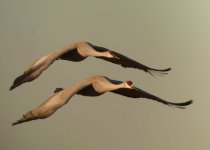Paul Hackett
Well-known member
Jeff Bouton said:Paul,
I will address your specific concerns to the best of my ability, but will then give up on "beating a dead horse" here. Those interested in advice or continued commentary from me are welcome, of course, to contact me privately, but I feel I'm beginning to belabor the same points here.
To be VERY honest with you Paul, I am here trying to help as a user who has had (again IMHO) great success digiscoping with this rig, as a birder not as a Leica employee. Before the introduction of the D-Lux 2, I used a Nikon Coolpix 4500. When I switched to the D-Lux 2 my percentage of "keepers" tripled. It is from this standpoint that I make my claim, that the D-Lux 2 & 3 are excellent cameras for digiscoping, as a counterpoint to those who claimed how "VERY disappointed" they were in the product, because I find this to be in direct conflict with my personal experience. Yes I work for Leica and certainly expect folks to take what I say with skepticism. However, I am being very upfront with my affiliations and am not trashing any competitor's products or pretending to be a neutral party. It's just not my style. I'm suggesting (as you imply as well) the camera does take great images.
I will not try to deal with specific claims of other cameras being better suited, as again to be very candid and frank, I haven't had opportunities to try them. I will only address what I know and not shoot up smoke screens. I will continue to stand by my claim that I find the D-lux cameras to be very effective because I personally continue to get great results every day and instead of arguing about this, I'm posting my images to let others judge for themselves.
I know definitively others are using many other P&S brands and models with great success, but from my personal experience I feel I can PROVE definitively that the D-Lux cameras DO take good images, because I have MANY.
I agree with your comment about the advantage of a cable release, and I hope we will see this in the future, in the interim I have images of a very simple solution that one user in the US made that works VERY well and can be added in about 5 minutes for any interested. I also appreciate your constructive criticism on what you would like to see improved on the adapters. This is the first generation on these products and as with any product lines it is likely that improvements will be discovered and made on subsequent models. Feedback from end users is THE VERY BEST criticism to get because it adresses true issues encountered in the field.
Regarding your claims of the overwhelming price, I'm afraid I don't agree with your take here. The Leica digital adapter is <1/2 the price of our competitor's branded solutions and at $599 US the D-Lux 3 is VERY competitively priced among other 8 mp, image-stabilized cameras, with a fast f/2.8 lens!
Lastly Paul, I'd like to comment about your observations about Leica not considering digiscopers in R&D... and the C-Lux not being designed as a digiscoping camera... etc.
OF COURSE this is true Paul! NO MANUFACTURER is desigining a "digiscoping camera" for one very simple reason. Even if you created the "Perfect digiscoping camera" and every other digiscoper in the world purchased the unit, you probably still wouldn't make enough money to cover your R&D and production costs! When developing these models planners are considering how many millions of units will sell in ~9-10 months (the average run time of new digital p&s cameras) and all considerations are (naturally) centered around producing a unit that takes stunning portraits, scenics, etc. as a stand alone unit! To even think that cameras are designed around digiscoping is IMHO a bit naive!
I'd be real curious to know if you counted every unique member of every digiscoping group worldwide, what the number of end-users would be? I suspect it's comparatively small, and given the overwhelming selection of cameras that lend themselves to digiscoping in today's competitive marketplace, how many units do you realistically expect a manufacturer would sell? Do the math, lets say very optimistically a manufacturer could sell 2,500 units and R&D costs were at $5 million. Said manufacturer would have to sell these at $2000 each just to cover R&D, let alone other expenses and making a profit!... Talk about an expensive camera!!! So I think we digiscopers need to be realistic here and give up on the idea that someone will create a camera that considers digiscoping as a primary use especially when >90% of sales are for portrait use!
The truth of the situation is these cameras are produced and if they produce good images through the scope then manufacturers try and consider an inexpensive way to attach this to the scope not the other way around. Sorry to be long-winded folks, but this last point is one I hear all the time that is not very realistic at all and I wanted to address.
As promised here are a handful of images I took 2 days ago with the D-Lux 3 through the Televid as proof of the image quality. Am I stating it is the best?.... I don't know, have tried enough of the others to really know, but I know the D-Lux camera has worked wonderfully for me over the past year. It mounts rapidly, and I've gotten definitive images (even high quality in most cases) of EVERY rare bird I've seen with it since last year. Again those interested in seeing more please contact me privately and I have a link to a site with over 100 images taken with the D-Lux 2 as well. I've been very happy with this camera and will continue to suggest it works very well not as a Leica employee but as a birder getting regular stunning images!
Paul, I look forward to meeting you here in the US in April and hope we can spend some time together digiscoping in the field. I'd like to compare results and learn more from you in person regarding your experience with equipment I've not had the opportunity to use.
Sincerely,
Jeff Bouton
>20 year professional field biologist, tour leader, and birder who also happens to work for Leica!
PS - These are just 4 of my favorite images out of ~150 taken in three hours in the evening after arriving here in NM 2 days ago (I can prove date and times through the EXIF files!) At any rate, I don't know about the rest of you, but from my perspective, I think the camera performs INCREDIBLY, and again I have NO complaints with the images I'm getting! (remember also these are greatly reduced/compressed for inclusion here)
PPS - Rentocharman, I'd like to talk to you more at length about what you are seeing. I have to admit that in general I carry the APO Televid 77 so will experiment more with the 62 to see if I notice any differing results. Regarding the black corners at the top of the screen, I would suggest double checking the two set screws are fully tightened (one that attaches to ocular, 2nd controls slide feature). If there is still some inherent play here the camera can sag and tilt upward resulting in these dark, upper corners. This could also cause other problems like uneven shading, etc. if the two lenses are not square to one another. Feel free to contact me personally to discuss.
Jeff
Thanks for a very informative reply,
just a couple of things
Ref my question regarding if you would point out the fault to the customer before they buy, that the adpater not being long enough and the camera lens hitting the eyepiece and switching off, could you answer that question please?
See a previous thread on this forum ref Leica Digiscoping
http://www.birdforum.net/showthread.php?t=54360
I am reading this thread and these people seem to have found out the problems AFTER they have purchased the product? Does that not strike you as a little odd? these are customer opinions
Some information upfront would go a long way to the customer so they have an informed opinion before they buy, as clearly the people on the previous thread did not.
I can accept the learning curve of the end user with new equipment, but to be then told the set up actually doesnt fulfill their expectations? or doesnt function to its full capacity?i.e. adapter length and touching lens switching off the camera. I presume the people mentioned in the thread have bought this product based on Leica literature they have read which told them the items purchased were compatible, and the Leica brand which is known for quality
Pricewise in the UK for suitable P & S digiscoping cameras, its still the most expensive camera
Jeff, the images are great that is not the point i am making, the camera is a quality product, no question, and so are the previous cameras, its just that the marriage of these two items is not great when you look at other cameras and adapters on the market, can we at least agree on that along with customers who have actually bought product who are also stating this, whether you are wearing your Leica hat or Birder hat?
I am also looking forward to some interesting and informative discussions and exchange of ideas when i come over.
Regards
Paul








